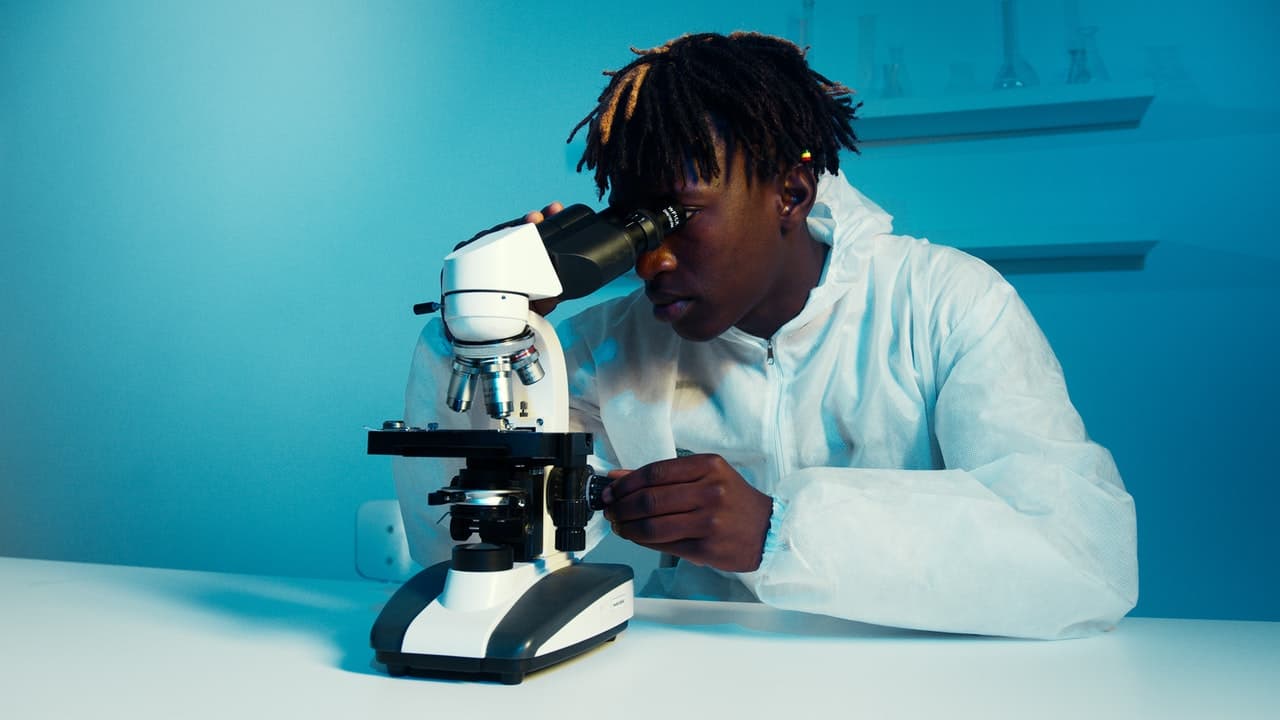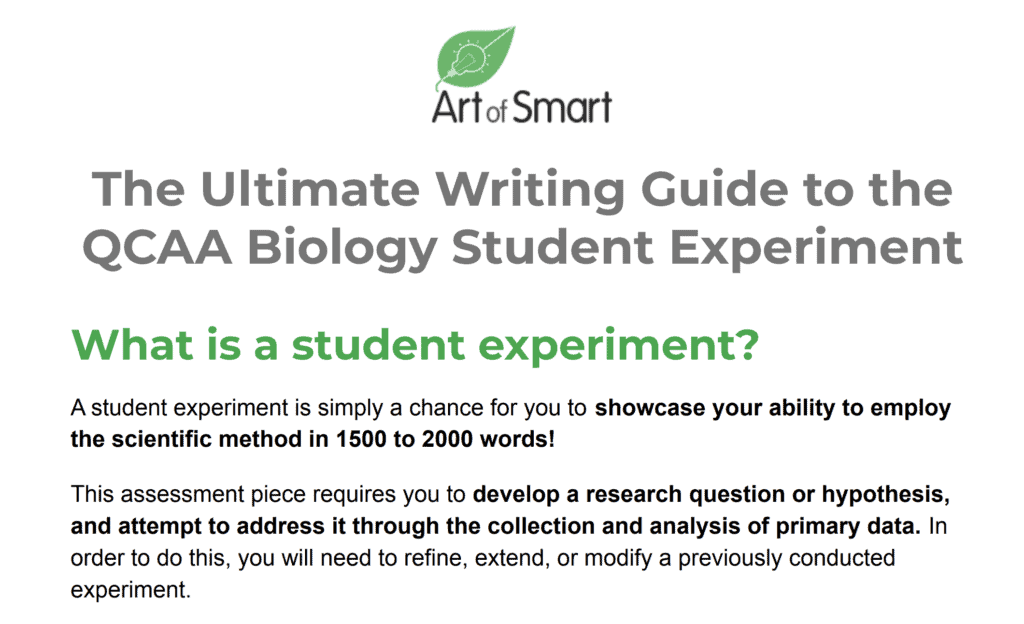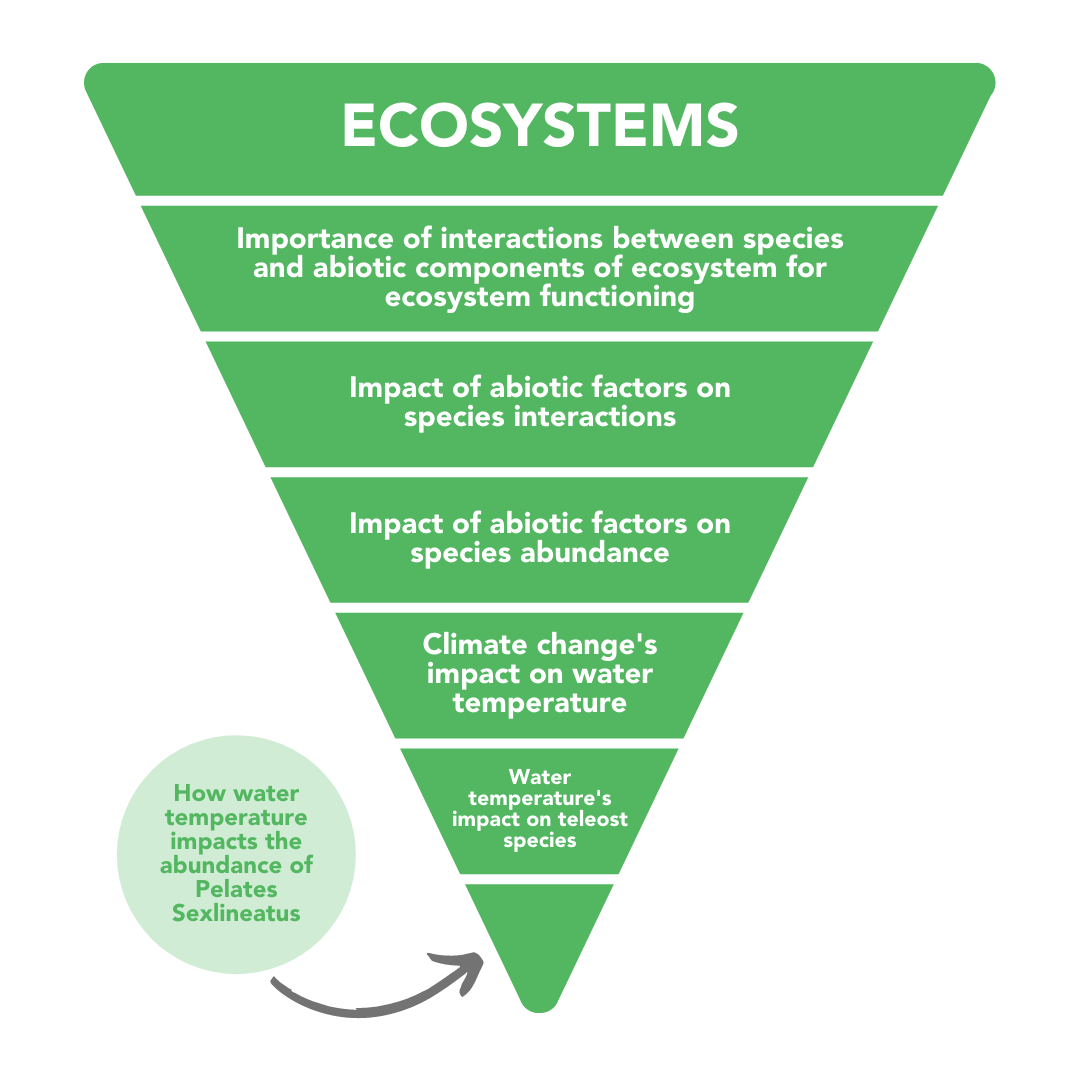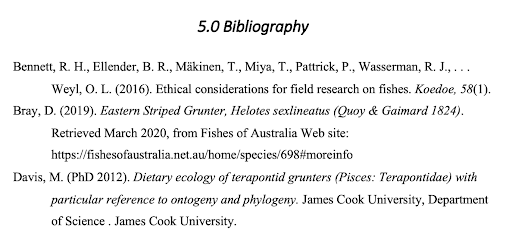Expected to write up a student experiment report for QCAA Biology but aren’t too sure how to approach the task?
We’re here to help you out! We’ll walk you through each of the different sections of the student experiment report for QCAA Biology, so that you’ve got a clear understanding of the structure.
What are you waiting for? Let’s get started!
What is a Student Experiment?
How do you write a Student Experiment for QCAA Biology?
QCAA Biology Student Experiment Report Structure
What is a student experiment?
A student experiment is simply a chance for you to showcase your ability to employ the scientific method in 1500 to 2000 words!
This assessment piece requires you to develop a research question or hypothesis, and attempt to address it through the collection and analysis of primary data. In order to do this, you will need to refine, extend, or modify a previously conducted experiment.
Want to see how you went in the IA1? Check out our QCE Cohort Comparison Tool to show you were you sit compared to your peers!
How do you write a student experiment for QCAA Biology?
To successfully complete this task, QCAA state that you must:
- Develop a research question to be investigated and conduct relevant background research to inform your modifications to the methodology
- Conduct a risk assessment and account for risks in the methodology
- Collect sufficient and relevant qualitative and/or quantitative data to address the research question
- Process and present the data appropriately to allow for the analysis of trend, patterns or relationships, as well as uncertainty and limitations
- Interpret the evidence to draw conclusion/s to the research question
- Evaluate the reliability and validity of the experimental process
- Suggest possible improvements and extensions to the experiment
In short, these are the steps you will need to follow:
Below is a breakdown for how, exactly, to complete a student experiment and hit all the marks along the way.
In the example below, the data used comes from the Moreton Bay Environmental Education Centre (MBEEC). Learn more about their different curriculum programs!
Please also keep in mind that this example has data for one particular species, and when writing up your own experiment, you will need to choose a different species to avoid any plagiarism.
QCAA Biology Student Experiment Report Structure
Step 1: Write Your Introduction
Rationale
The bulk of your research and background theory should be contained within the rationale.
It is important that you show the development of your investigation through the rationale! You can’t simply jump straight to the crux of the investigation, as that doesn’t give any indication as to why you are doing the investigation and any important information that has informed your question.
For this reason, it can be helpful to think of your rationale as a funnel through which you are feeding the reader information.
For example, let’s look at the rationale mapping for an investigation into how climate change’s influence on water temperature impacts the abundance of a species of a fish species known as Pelates sexlineatus.
It’s also important to make sure that your rationale addresses every component of your research question! The purpose of your rationale is, after all, to show how the question has been developed. You should also show how you have considered your modifications to the original experiment.
To get top marks, your rationale must be “considered”. What does this mean?
Your rationale must discuss any theory that is important for the investigation. You must also show that your modifications to the methodology have been informed by theory. Using the funnel method shown above can help you produce a considered rationale.
QCAA Biology Student Experiment example: Climate Change Impacts on Marine Ecosystems (2012), authored by Scott. C. Doney, et al., investigates the detrimental consequences marine ecosystems are facing, resultant of anthropogenic climate change. When regarding ecological timescales, a central problem posed by climate change is the rising levels of atmospheric carbon dioxide (CO2) (Doney, et al., 2012). The significance of this issue is due to its global prevalence and damaging nature (Doney, et al., 2012). It can be noted that the primary effect increasing CO2 levels has on the ocean is rising temperatures. Doney et al. identified that fluctuations in ocean temperatures may ultimately impact the functioning of ecosystems. Varying and heightened temperatures have the potential to alter the “physiological function, behaviour and demographic traits [for example, productivity] of organisms” in marine ecosystems (Doney, et al., 2012). Additionally, this may lead to a subsequent decrement in the abundance of organisms within species. Ultimately, ocean temperatures regulate species interactions and behaviour – particularly the behaviour of ectotherms – and fluctuations in temperature can result in changes to trophic pathways.
Original Experiment
This does not need to be incredibly lengthy — a few sentences tacked on to the end of your rationale will suffice! All you need to do is:
- State the aim of the original experiment
- Identify some of the limitations that will be addressed by your investigation
To get top marks, you must demonstrate that your modifications to the methodology are “justified”. By identifying the limitations of the original investigation, you are making it much easier to justify your own modifications!
For example: The original investigation aimed to investigate how a multitude of abiotic factors affect the distribution of the species Chrysophry auratus in Moreton Bay. This investigation is limited in that: 1) abiotic data has been omitted for all measurements taken prior to 2015, and 2) the analysis lacks specificity since it investigates a variety of abiotic factors — thus, the data is only being examined at surface-level.
Developing a Research Question for your QCAA Biology Student Experiment
When developing your research question, the goal is to generate a question that is succinct and specific enough to provide results that can be analysed with ease. You want to ensure that both your dependent and independent variables are not only included in the question, but operationalised.
To make your research question even better, prompt the investigation to seek directionality. Instead of asking, “Does X impact Y?”, ask “How does X impact Y?”.
By only asking “Does”, you are asking a yes or no question. The inclusion of “How” necessitates a more in-depth investigation of the relationship between the variables.
To get top marks, your research question must be “specific” and “relevant” — but what does this mean? This means that you have to really consider the variables you are exploring and make sure that your question is linked nicely to your rationale. Every aspect of your research question should be addressed in the rationale.
For example: How has climate change’s impact on the abiotic factor of water temperature (˚C) affected the abundance of P. sexlineatus, between 2015 and 2018, at Moreton Bay?
Step 2: Define Your Methodology
Original Method
It’s important to note that you don’t need to include a step-by-step guide on how to conduct the original experiment. You simply just need to provide a general idea of how the original methodology attempted to address the aim.
For example: The original methodology, on which this report is based, utilised a baited remote underwater video station (BRUV) in order to attract and record marine species in the vicinity.
Modifications to Methodology
This section should also not be mistaken for a step-by-step guide on how to conduct the new experiment. What this section should include are the ways you have changed the methodology for your own Biology student experiment.
You can show this through the inclusion of refinements, extensions and redirections. It is also important to indicate how these modifications improved the original method and addressed any limitations.
To get top marks, you must show that your modifications are “justified” and that your methodology allows you to collect “sufficient” and “relevant” data. This can be achieved simply by showing how your investigation is an improvement of the original.
For example: The key refinement to the original experiment is the alteration of the species of focus … [This] refinement allow[s] for the analysis of relevant and appropriate data and ensures that the investigation is specific. Extensions include examining the links between the abiotic factors of water temperature, water depth and season … [This] extension allow[s] for the insightful analysis of data — ensuring it is assessed beyond the surface level … Redirections include … investigating the effects of climate change on the species abundance of P. sexlineatus, due to its impact on water temperature. [This] redirection allow[s] for the investigation to fill gaps in the scientific understanding presented by the original study.
Management of Risks and Ethical Considerations
In this section, you need to identify any major safety risks and ethical concerns that were posed by the investigation. It is also crucial that you elaborate on how these risks and ethical concerns were addressed.
To get top marks, you must show that your management of risks and ethical concerns is “considered”. You can do this by showing that these risks and concerns were taken into account before you even conducted the experiment.
For example: As the methodology consisted solely of analysing pre-collected data from a reputable source, no safety risks were identified. However, ethical considerations have been noted when examining the data collection technique implemented throughout the original study. The non-invasive nature of BRUVs ensures they do not harm organisms; although, in some instances, its deployment may cause damage to the surrounding habitats. The effects of this can be mitigated should the investigator aim to deploy the BRUV thoughtfully.
Up until this point, the only criteria that has been assessed is:
Refer to the “To get top marks” component of each subsection to see how you can ensure you meet all of the criteria.
Step 3: Generate Results from Your Student Experiment
Descriptive Statistics and Inferential Statistics
In this section it is imperative that you discuss any trends, patterns or relationships that you see in the data. Further, you should make an effort to link your observations back to the research question as much as possible.
You may also wish to present your data in a graphical or tabular format in this section (however, ensure you include error bars and/or uncertainty).
Additionally, you should discuss the significance of your results. You can do this by analysing the error bars on your graph… Ask yourself, are they overlapping? If so, your data isn’t statistically significant.
You can also employ the use of inferential tests to determine statistical significance. For any calculations you do, however, you should include an example in this section.
To get top marks, you must demonstrate the “appropriate” application of mathematical procedures, as well as “appropriate” “visual” and “graphical” presentations of the data. Additionally, you must identify trends, patterns, or relationships that are relevant to the investigation — you can do this by ensuring you link your observations back to the question.
QCAA Biology Student Experiment example: The mean number of P. sexlineatus increases almost twofold at temperatures ≤22˚C, compared to temperatures >22˚C. With a confidence interval of 95%, it is expected that the mean number of P. sexlineatus at temperatures less than 22˚C is 22±6.94. However, at temperatures ≥22˚C this value is reduced to 10±3.76. This relationship between the abiotic factor of water temperature and the abundance of P. sexlineatus is supported by scientific literature; this marine species prefers cooler water temperatures (operationalised as temperatures below 22˚C). When comparing the abundance of P. sexlineatus at temperatures above and below 22˚C, a p-value of 0.004 was produced … As this value is less than 0.05, it can be deduced that the results are statistically significant, and that water temperature does influence the abundance of the species.
Limitations
Here you will comment on any sources of error or uncertainty, as well as any shortcomings of the methodology that have potentially impacted your ability to accurately answer the research question or draw a conclusion.
It can help to break this section up into limitations concerning the data and limitations concerning the methodology. This will make it easier to write up the reliability and validity section, as reliability concerns data and validity concerns methodology.
According to the QCAA, to get top marks you must demonstrate the “thorough” and “appropriate” identification of uncertainty and limitations. This means that you must comment on and acknowledge how the uncertainty and limitations impact your ability to draw causal conclusions or answer your research question.
For example: Limitations concerning the data include: some measurements exhibited larger confidence intervals, relative to the mean (indicating uncertainty) … Limitations concerning the methodology include: the type of bait used might impact the species that are attracted to the BRUV – it has been identified that P. sexlineatus primarily feed on crustaceans; however, the bait used was not crustaceous.
Analysis of Results
In this section of the Biology Student Experiment, you must talk about what your results mean with regard to answering the research question. You can also talk about what you expected the results to look like and compare that to what was actually seen.
If desired, you can do further research to gain any theory (that isn’t contained within the rationale) that may help you explain the results.
To get top marks, you must draw “justified” conclusions that are “linked” to the research question. By linking your observations back to the theory and making very explicit connections to the research question, you can tick off this criteria.
QCAA Biology Student Experiment example: Water temperature has a significant effect on the abundance of P. sexlineatus … The data shows that there is an inversely proportional relationship between water temperature and P. sexlineatus abundance. Further, water temperature is understood to be directly influenced by climate change … Upon conducting further research, it has been recognised that the metabolic rates of aquatic organisms has a directly proportional relationship with water temperature (Fondriest Environmental, Inc., 2014) … Increased metabolic rates may be detrimental to the health of aquatic organisms if maintained for extended periods of time (Fondriest Environmental, Inc., 2014). Ultimately, these physiological responses cause behavioural changes such as relocation, which impacts the measurements of species abundance. Thus, being a cold-water species, it can be deduced that climate change negatively affects the abundance of P. sexlineatus via increases in ocean temperature.
Step 4: Interpret and Evaluate Your Investigation
Reliability and Validity
Here you must elaborate on the reliability and validity of the investigation.
Reliability relates to the data, so you can discuss things like the uncertainty of the data or any error that may impact the ability to draw a conclusion.
Validity, on the other hand, refers to the methodology. If the methodology wasn’t appropriate then you cannot draw a valid conclusion as the investigation won’t produce results that are relevant to what you are examining.
To get top marks, you must have a “justified” discussion of the reliability and validity of the investigation. This means talking about how the limitations don’t stop you from being able to draw a causal conclusion.
For example: It has been identified that the data lacks inter-rater reliability, due to the high degree of dispersion – indicating a lack of consistency. However, the results are reliable in that they hold statistical significance. This is observed in the t-tests and in the fact that the error bars do not overlap – furthermore, most error bars are quite infinitesimal relative to the size of the means. The validity is strong as the methodology allows for the accurate identification of fish species (ultimately ensuring the content validity of the results).
Improvements and Extensions
In this section, you address any limitations to the investigation that you identified in the limitations section. If there are any ways to improve the reliability or validity of the investigation, then you should state that here.
Further, you should discuss how this investigation can be extended further to investigate something new or fill any other gaps in knowledge that were uncovered during this investigation.
According to QCAA, to get top marks in your Biology Student Experiment, you must suggest improvements and extensions that are “logically derived” from your analysis of the evidence. You can achieve this by ensuring each of the limitations you identify in the limitations section maps to an improvement in this section.
QCAA Biology Student Experiment example: Suggested improvements that will enhance the reliability and validity of the data and methodology include: using crustaceous bait (in order to better attract P. sexlineatus), collecting data from various localities in Easter Australia (so as to examine whether the high level of dispersion is typical) … Extensions include: examining how other abiotic factors (also influenced by climate change) affect the abundance of species (i.e. ocean acidity), and investigating the impact climate change has on species residing in intertidal zones.
For the sections in steps 3 and 4, the following criteria are being assessed:
Refer to the “To get top marks” component of each subsection to see how you can ensure you meet all of the criteria.
Step 5: Write Your Conclusion
Here, you simply summarise the results and your answer to the research question.
For example: Between 2015 and 2018, it can be deduced that Moreton Bay’s abundance of P. sexlineatus has been negatively impacted by climate change – due to its effects on water temperature (notably, causing increases in temperature). This is due to the fact that increased temperatures result in behavioural changes in ectothermic species.
Step 6: Include a Reference List In Your Student Experiment
For example:
Note: this exemplar uses APA style referencing.
Step 7: Include an Appendix
Here you can include raw data and any calculations you have performed. This section is not marked, nor does it contribute to the word count. However, this section allows you to include any supplementary information to aid your report.
For example:
There you have it!
We’ve given you a step-by-step guide on how your student experiment report for QCAA Biology should be structured. Hopefully you’re feeling way more confident to complete your task now!
If you’ve been looking for other resources to help you study for QCAA Biology, here are some you can access:
- Unit 3 Biology Data Test IA1 Practice Questions
- Unit 3 & 4 Biology External Assessment Practice Questions
- Unit 3 & 4 Biology External Assessment Multiple Choice Practice Questions
- The Essential List of QCE Biology Terms You Need to Know for Unit 3
- The Ultimate Guide to QCE Biology Unit 3: Biodiversity and the Interconnectedness of Life
Are you looking for some extra help with the Student Experiment for QCAA Biology?
We have an incredible team of QLD Biology tutors and mentors!
We can help you master the QCAA Biology syllabus and ace your upcoming Biology assessments with personalised lessons conducted one-on-one in your home or online!
Need a tutor on the Gold Coast region? We’ve got you!
We’ve supported over 8,000 students over the last 11 years, and on average our students score mark improvements of over 20%!
We offer support for regional areas too! Check out our expert Townsville tutoring team!
To find out more and get started with an inspirational QLD tutor and mentor, get in touch today or give us a ring on 1300 267 888!
Katelyn Smith was a pioneer in the Queensland ATAR system. After graduating in 2020 with an ATAR of 98.40, she now studies a Bachelor of Advanced Science (Honours) at The University of Queensland — majoring in Physics. Through her studies, she hopes to develop a greater appreciation for how the wonders of the universe work. When she isn’t slaving away behind her unnecessarily large textbooks, she enjoys catching up with friends, scrolling mindlessly through TikTok, and sleeping.











